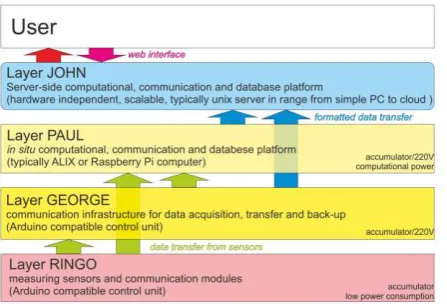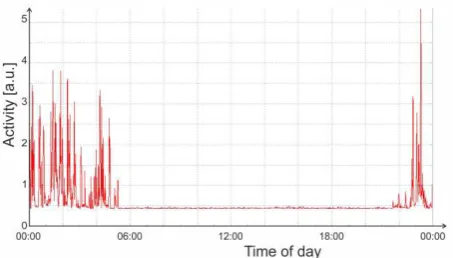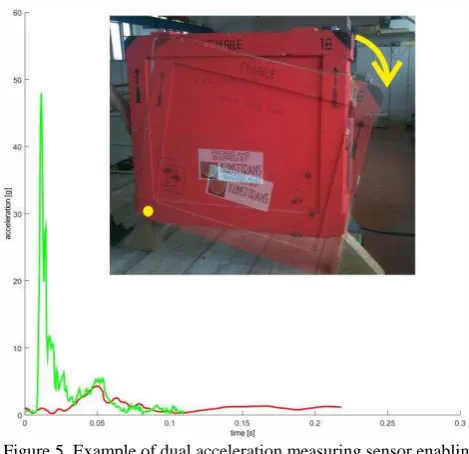EVERYTHING IS DATA
–
OVERVIEW OF MODULAR SYSTEM OF SENSORS FOR
MUSEUM ENVIRONMENT
J. Valach a,*, K. Juliš a, P. Štefcováb, M. Pechb, B. Wolfa, M. Kotykb, J Frankla
a Institute of Theoretical and Applied Mechanics of Academy of Science of CR, v.v.i., Prosecká 76, 190 00 Prague 9, Czech Republic - {valach, karel, wolf, frankl}@itam.cas.cz
bNational Museum, Václavské náměstí 68, 115 79 Prague 1, Czech Republic - {petra.stefcova, michal.pech, michael.kotyk}@nm.cz
Commission E, E-7
KEY WORDS: Museum, indoor environment, sensors, integrated pest management, monitoring, semantic data
ABSTRACT:
The main aim of project nearing completion was to develop a modular and scalable system of sensors for monitoring of internal environment of museum exhibitions and depositories. The sensors vary according to parameters being monitored and at the same time also according to required energy autonomy, processing capability and bandwidth requirements. Sensors developed can be divided into three groups: environmental sensors, biosensors and sensors of vibrations. Data acquired by the sensors are archived and stored in open format. Metadata stored alongside true numerical data from measurement, represent assurance of future computer readability in data mining application. Long continuous series of data can provide sufficient data for acquisition of dose-response function.
* Corresponding author.
1. INTRODUCTION
National Museum of the Czech Republic is largest state-owned museum in the country. Under its umbrella it manages and curates large collections of much diversified nature. As objects in collections range from minerals to precious works of art, any possible decay mechanism known to operate upon collections can be found there. The museum is responsible for many collections of diverse nature, which implies that also threats of the protected item differ significantly (Štefcová 2014a). Naturally, there is profound interest to improve care for collections by introducing computer-assisted monitoring methods.
2. MOTIVATION
The project is dedicated to development of integrated and modular system of sensors for monitoring of cultural heritage objects by means of processing of on-line records of environmental parameters of depositories and collections located in CH buildings, museums, galleries, etc. (On another implementation of systems for monitoring of museum environment see e.g. Camuffo 2001). Therefore the core of this project is development of hardware platform alongside with a unified data structure. (For more details on the project see Štefcová 2012, Valach 2014, Štefcová 2014b).
3. SENSORS AND COMPONENTS
The main aim of the system is to integrate various detectors in one platform, make data available long term and also in format readable and easy to process in on-the-fly manner as well as ad hoc. A complex hierarchy of sensors, control units and communication units was developed to meet every possible scenario concerning required processing power, available or lacking energy supply and site connectivity to internet as shown
on Figure 1. Only a subset of designed and developed sensors is presented here (for further information see: Valach 2014). In most typical scenarios, sensors are often used in internal climate control, but once data is processed, the data is deleted, however long-time records are invaluable for re-adjustment of safe limits of environmental parameters limiting or stopping entirely decay of collected items. These records can also be used for parametrization of empirical dose-response functions relating material decay and environment.
3.1 Autonomous sensors
Sensors were developed to measure environmental data. Most of them are to be deployed in inaccessible locations, therefore enduring independent operation is of high importance. It means goal was to build sensors capable of battery powered operation for units of years to eliminate necessity of intervention that could be damaging monitored collection.
Figure 1. Schematic depiction of device hierarchy ordered from bottom to top according to increasing data acquiring and
processing capabilities and also energy requirements. The International Archives of the Photogrammetry, Remote Sensing and Spatial Information Sciences, Volume XL-5/W7, 2015
25th International CIPA Symposium 2015, 31 August – 04 September 2015, Taipei, Taiwan
This contribution has been peer-reviewed.
Importance of long-term autonomous operation becomes clear once not only installations in the remote and infrequently visited depositories are considered, but also are taken into account installation in display case alongside exhibited objects to suppress cables and other visual distractions to visitors. Environmental parameters like temperature, relative humidity, corrosivity (Juliš 2014), vibrations, and cumulative radiation energy exposure are measured, stored and (wirelessly) transmitted from several sensors to aggregating server. The server compares continuously measured variables to safe margins of operation and if the limits are exceeded, it alerts museum staff.
3.2 Biosensors
Biological pests represent a significant danger to collections, thus biosensors are important component of integrated pest management system. Usually sticky tapes with attractants are installed in places of expected pest occurrence, but it requires frequent inspections to count entrapped insect and the state of trap itself. Biosensors are based on combination of attractive pheromone traps and image analysis processing of image sequence recorded by sensor’s camera (as shown on Figure 2 and Figure 3). Systems similar to the presented one are described e.g. in (Guarnieri 2011, Noldus 2002 and Reynolds 2012). Only if a pest is indicated, museum worker is send a message by the system. This way burden of processing is left on control unit of sensor instead on operator or museum worker.
The biosensors developed exploit simplicity of sticky tape traps design with on-line knowledge of state eliminating drawback of traps – necessity to evaluate them by museum staff. Laborious inspections of pest traps prevent massive deployment in collections, but enhancing with sensors and automatic state of the traps promise to overcome this limitation.
Sensors allow for image analysis of software evaluates image captured by web camera, closed-loop program looks for
changes from previous recorded states and sends alert to museum worker either via email or vie text message (SMS). It means the staff attention is required only when alert is received. The solution is also advantageous in the sense that only limited data bandwidth is sufficient for alert delivery, because no image data has to be transmitted. This setup allows depositories and other museum premises to be watched for remotely and economically.
Biosensors were developed to be low cost, based on off the shelf components and mechanical parts of the sensors are produced on 3D printer to allow simple reproducibility by any museum interested in adopting freely available design and open-source control software (see Figure 4). One single board server is capable to process images from two biosensors and also signal from several environmental sensors further reducing cost of system purchase and maintenance.
3.3 Sensors of vibrations
Vibrations can lead to cracks, paint detachment, displacement or other damage types of museum objects (see Saunders 1998 and Stolow 1981). Developed sensors are unique in their ability to simultaneously record accelerations and environmental parameters on the surface of transport box and on the protected object itself (Valach 2014). Therefore the sensors can be used for improving transport protection (Figure 5).
Vibration sensors are used in two different modes – stationary mode for analysis of local vibrations possibly endangering displayed objects in exhibition locations, and transport mode for surveillance of objects’ conditions during transport (Figure 6). Sensors monitor vibration levels in buildings, either caused by traffic or by walking of visitors. Safe level of vibrations has to be known before proper data evaluation. Assessment of damage caused by vibrations is discussed e.g. in (Johnson 2013, Marcon 2014 and Thickett 2002). However vibrations themselves cause any direct damage only infrequently, it happens quite often that they contribute to damage indirectly, typically due to fall of object from shelfs in display cases, therefore once a certain level of vibrations is reached, precautions have to be undertaken – waxing objects to shelfs, installing high friction fabrics on the shelfs, etc.
Figure 2. Visual detection of insect in biosensor, showing reference image (left) and the image with a cockroach (centre). Difference between the two images is evaluated as shown on the
right part of the figure.
Figure 3. Output from biosensor shown in Figure 2 represent records in image differences quantifying pest activity during the
day, indicating a nocturnal peak activity of the pest.
Figure 4. Unified platform of biosensors, based mostly on 3D printed components. The same camera top part can be used for
detection of crawling or flying insect. The International Archives of the Photogrammetry, Remote Sensing and Spatial Information Sciences, Volume XL-5/W7, 2015
25th International CIPA Symposium 2015, 31 August – 04 September 2015, Taipei, Taiwan
This contribution has been peer-reviewed.
4. DATA FORMAT AND PROCESSING
Acquired data are partly processed locally and also stored in unified format on server for consequent data-mining. Therefore data are stored in XML format to accommodate also metadata necessary for subsequent interpretation in computer understandable format. Open, human readable format guaranties the data to be “future-proof”, not following fate of many special formats of data, now obsolete and lost for re-use. In long run vast collection of data makes possible to parameterize dose-response function for decay of various types of materials and environmental conditions in expositions or depositories. The aim of extended data processing and analysis is to investigate correlations between collection’s state and recorded parameters of indoor environment. This topic is considered as follow-up research after finishing project presented in this paper.
Server-side of the modular system, a data-base called Amusing (abbreviation from Automated MUSeum monitorING) concentrates data from various sensors located at branches of National Museum for storage and data mining processing. A user-friendly web interface allows platform independent analysis of heterogeneous data records from every place equipped with sensors (Figure 7). User can select the museum building, recorded parameter, time interval to be analysed. System plots interactively graph of given variables time history and also other known data concerning the selected place. Thus user is offered in one unified view requested data dynamically plotted as well as the other relevant data. Complex tree structure is necessary to cover all towns, all branches of National Museum, floors and rooms and sensors in selected room. Several variables can be selected and displayed at once either in one plot or in two separate plots. For more detailed and specialised analysis system allows export of dataset and computer readable format.
Museum buildings and branches are described in detail on information cards. Cards which aggregate information on installed sensors are also instantly available. The sensors allow for setting alarms on every suitable variable and also specific set of actions to be initiated when alarm is on. For example, when RH exceeds certain limit for a specified duration of Figure 5. Example of dual acceleration measuring sensor enabling
optimization of transport box design in order to maximize attenuation capabilities and thus object’s protection. Example of drop test acceleration measurement: green line – accelerations on
transport box, red line – acceleration on object (painting) inside. Painting faced about ten time lower accelerations then the box.
Figure 6. Transport sensor for internal climate monitoring in transport box protecting precious manuscript. In addition to
autonomous operation for several months, Bluetooth connection can be used for proper handling care as it allows to
eliminate thermal shocks to protected object when the box is open prematurely without adjusting gradually temperature in
the box to the temperature in the room.
Figure 7. User web interface to AMUSING system allowing on-line access to sensors and complex database queries and control and monitoring of network of sensors. The panel A enables user to select location to be inspected on hierarchy town – building –
floor – room – sensor, to choose variables to be plotted in graphs below (B), to determine time interval of interest (C). In
addition to plot, also summary information of object and sensors is displayed (D). Other functions and services are
accessible on panel (E).
The International Archives of the Photogrammetry, Remote Sensing and Spatial Information Sciences, Volume XL-5/W7, 2015 25th International CIPA Symposium 2015, 31 August – 04 September 2015, Taipei, Taiwan
This contribution has been peer-reviewed.
time, an alert email as well as text message (SMS) is sent to a responsible person. All alarms are stored for subsequent evaluation occurrence analysis, museum policy adjustment… Databases can store heterogeneous data – time records or sequence of images.
CONCLUSIONS
Specialised sensors addressing specific needs of museum’s collections were developed. The sensors are mutually compatible and complementary in their capabilities and in combination with dedicated servers form a modular system. The hardware is “wrapped” in user interface allowing complex task in collection monitoring and data analysis.
One of the contemplated applications exploiting the accumulated data would be the adjustment of ranges of safe or acceptable margins of environmental parameters for storage of various types of materials. It would be also possible, in the case of the simplest materials, to combine recorded indoor climate data with so called dose-response functions for rate of degradation prediction.
Ultimate intention is to quantify true interrelation between the museum environment and damage in collections, which somehow follows lord Kelvin’s(1883) famous quote: “I often say that when you can measure what you are speaking about, and express it in numbers, you know something about it; but when you cannot express it in numbers, your knowledge is of a meagre and unsatisfactory kind; it may be the beginning of knowledge, but you have scarcely, in your thoughts, advanced to the stage of science, whatever the matter may be.”
ACKNOWLEDGEMENTS
The project “Unified modular system of remote on-line monitoring of environmental parameters of depositories and expositions” is supported by the program of applied research and development of national and cultural identity (NAKI) of the Ministry of Culture of the Czech Republic – grant No. DF12P01OVV27.
REFERENCES
Camuffo 2001: Environmental monitoring in four European museums, Atmospheric Environment 35 (Supplement 1), pp. 127-140.
Guarnieri 2011: Automatic trap for moth detection in integrated pest management. Bulletin of Insectology 64.2, pp. 247-251.
Johnson 2013: ‘Vibration Control during Museum Construction Projects’, Journal of the American Institute for Conservation, 52 (1), pp. 30–47.
Juliš 2014: ‘Sensors for monitoring corrosivity of indoor environment of museum exposition’, p. 84, in: Abstract book of 11th International conference Indoor Air Quality in Heritage and Historic Environments, Prague, April 13-16, 2014.
Kelvin 1883: Lecture on "Electrical Units of Measurement", Popular Lectures, Vol. I, p. 73
Marcon 2014: Agent of Deterioration: Physical Forces,
http://www.cci-icc.gc.ca/resources- ressources/agentsofdeterioration-agentsdedeterioration/chap01-eng.aspx (0/06/2014).
Noldus 2002: Computerised video tracking, movement analysis and behaviour recognition in insects. Computers and Electronics in Agriculture 35.2, pp. 201-227.
Reynolds 2002: Remote-sensing, telemetric and computer-based technologies for investigating insect movement: a survey of existing and potential techniques. Computers and Electronics in Agriculture 35.2, pp. 271-307.
Saunders 1998: Monitoring Shock and Vibration during the Transportation of Paintings, National Gallery Technical Bulletin, 19, pp. 64–73.
Štefcová 2012: ‘Modular system of Sensors for Monitoring of Museum Internal Environment’, International Journal of Heritage in the Digital Era, 1, pp. 39-42. ISSN: 2047-4970, DOI: 10.1260/2047-4970.1.0.39.
Štefcová 2014a: Pest management in museum collections and storage areas (new approach-online sensors for pest detection). Journal of Environmental Science and Engineering A. 3, pp. 163-176. ISSN 1934-8932.
Štefcová 2014b: Project “Unified modular system of remote on -line monitoring of environmental parameters of depositories and expositions”, pp. 1-4, in: Proceedings of Pre-conference workshop, Museums and the Web conference, Florence.
Stolow 1981: Conservation standards for works of art in transit and on exhibition, Procedures and conservation standards for museum collections in transit and on exhibition. Unesco, Paris.
Thickett 2002: Vibration damage levels for museum objects. ICOM Committee for Conservation, ICOM-CC: 13th Triennial Meeting, Rio de Janeiro, 22-27 September 2002. ICOM-CC; James & James, London, pp. 90-95.
Valach 2014: Mobile device for monitoring of artefacts during transportation. In Ioannides, M.; Magnenat-Thalmann, N.; Fink, E.; Yen, A.; Quak, E. (ed.). EuroMed 2014: Digital Heritage. Progress in cultural heritage documentation, preservation and protection. Hockley: Multi-Science, pp. 442-451. ISBN 978-1-907132-47-6.
The International Archives of the Photogrammetry, Remote Sensing and Spatial Information Sciences, Volume XL-5/W7, 2015 25th International CIPA Symposium 2015, 31 August – 04 September 2015, Taipei, Taiwan
This contribution has been peer-reviewed.


